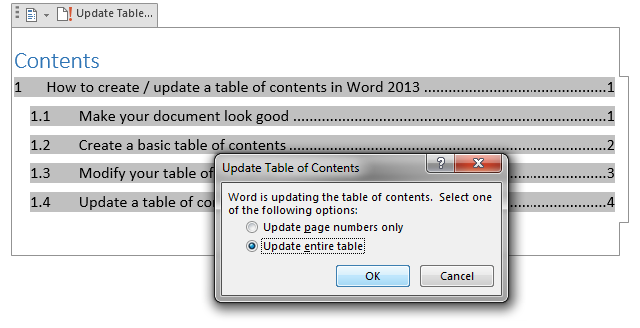

This will also turn the hyperlinked text purple, which seems to have no purpose whatsoever. Try this trick, “ctrl” + click, before you panic if you are unable to click directly on your newly hyperlinked chapter head. A table of contents often abbreviated as TOC is what outlines the titles and/or gives a brief description of the first-level headers, second level headers or even third level headers in more. I use the word “should” because in some versions of Word it is necessary to hold down the control key and then click to make the hyperlink work, the little pointing finger does not appear. Next select the bookmark which corresponds to the highlighted chapter head, in this example “fake_ch1,” and then click on “ok.” At this point, if all has gone well, the link should turn blue and underlined and be actively hyperlinked. On the References Ribbon, in the Table of Contents Group, click on the arrow next to the Table of Contents icon, and select Custom Table of Contents. Place your cursor where you want your table of contents to be.

In the table of contents, highlight the chapter head and click on the “hyperlinks” tab at the top of the page, then select the left-hand button labeled “place in this document.” This will bring up the bookmarks you just made for the chapter headings throughout the manuscript, as shown below. If you have used Heading styles in your document, creating an automatic table of contents is easy. It’s time to go through the table of contents and hyperlink the individual chapter heads to the corresponding heads in the text. So now you’re all bookmarked and ready for the main event. Go through the entire manuscript and do this for all chapter headings and any back and front matter you have included in the table of contents. Keeping in mind that spaces are not allowed, I will name my first chapter bookmark “fake_ch1.” Then, just like with the TOC head, highlight the chapter head, click on “insert,” then “bookmark,” and finally name your bookmarks according to the naming convention you have selected, and choose “add,” as illustrated below. I recommend using a shortened form of the title, just to keep things straight or in case you ever decide to sell multiple books bundled together. Next up, it’s time to through the manuscript and bookmark the chapter heads at the start of each chapter. Smashwords in particular seems to look for this exact reference name, so don’t get creative.Īll right, that’s one down. Enter “ref_TOC” here and then click “add,” as illustrated in the screenshot below. From the options now displayed at the top of your screen, select “bookmark.” A pop-up screen will appear requesting the bookmark name. First highlight the words “table of contents” and then click on the “insert” tab at the top of the document. Repeat this procedure with all the chapters and sections (if any).The next step is to create a bookmark. If you have sub-sections as well, select sub-section name and click on Heading 3.If you have sections also, select section name and click on Heading 2.Click on Heading 1 given under Styles in the Home tab (MS Office version 2007).However, because that page became quite popular and required occasional updating - including with various links to related tips and other materials - you should navigate to it using the link below to. The important thing is that you style these chapter/section/subsection names with heading styles. The original information in this post about automatically creating a Table of Contents in WordPerfect was mirrored from a page on my web site. This guide solves your day to day MS Word problems. NOTE: This article is part of my MS Word Guide. You could very well put content just under chapters without having any sections or subsections. It’s not necessary that you use sections and subsections.

The depth of this hierarchy depends on your documents. While you are preparing your document you should use heading styles for chapter names, section names and subsection names. In order to automatically create TOC, you need to do a few things before staring the process of actually making TOC.


 0 kommentar(er)
0 kommentar(er)
